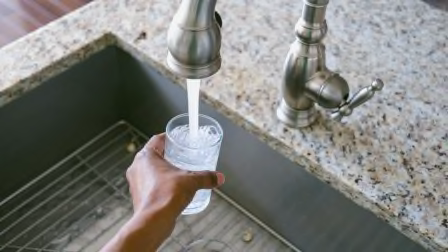“What began as a so-called miracle, groundbreaking technology, meant for practicality and convenience, quickly became one of the most pressing environmental and public health concerns in the modern world,” said Michael Regan, administrator of the EPA, at today’s press conference. Regan announced the proposal today in Wilmington, N.C., an epicenter of PFAS pollution and activism. In Consumer Reports’ tests two years ago of 120 drinking water samples across the country, the highest levels came from a church in North Carolina.
Where the EPA’s earlier guidelines suggested that the total levels of two of the PFAS chemicals studied most closely, PFOA and PFOS, should not exceed 70 parts per trillion (ppt) in drinking water, today’s proposed rule would limit them to just 4 ppt each.
Brian Ronholm, director of food safety policy at Consumer Reports, called the proposal “monumental,” adding that the EPA “did a really good job in following the science on this.” He also notes, however, that the EPA, along with other federal agencies, state regulators, and independent researchers, still has a lot of additional work to do, "considering these proposed limits apply to only a handful of the thousands of known PFAS, many if not all of which are also known to pose health risks."
The EPA has hinted over the past year that it was giving the health risks of PFAS exposure a closer look. Last summer, the agency proposed designating PFOA and PFOS as hazardous substances under the “Superfund” law, and indicated with new “health advisory limits” last summer that there was evidence of harm to human health at PFAS levels nearing zero.
Critics of those health advisory limits—including the American Chemistry Council, an industry trade group that sued the EPA over the limit—say that those limits are lower than what most current tests are able to detect, making remediation and enforcement impossible.
But those low levels—0.004 ppt for PFOA, for instance—were mathematical calculations of what would be safe levels for a lifetime of exposure to these chemicals, based on scientific research.
Experts say the EPA’s new proposed limit of 4 ppt is a compromise between the ideal level for public health (which would be close to zero), and what is actually achievable, given how pervasive PFAS are in our environment.
When the EPA released the dramatically low health advisory last year, “We knew then that they were reacting to the evidence that just kept coming out, that the levels at which health effects were being observed in animal studies were much lower than previously thought,” says Tunde Akinleye, a chemist in CR’s food safety division who has led several testing projects measuring PFAS in water. “But we also knew then that eventually reality would kick in, and that the limits would not be 0.004. So, they are proposing 4.”
In 2020, CR tested samples from a representative mix of 120 water systems across the U.S. for 30 different PFAS. While PFAS were detected in nearly every sample, only two samples were above the EPA guidelines at the time for PFOA and PFOS. If the new proposed limits were law back then, 27 water systems, or over 22 percent, would have exceeded them.
Today’s proposed rule only applies to public water systems in the U.S., and not private wells, which about one in eight Americans rely on for drinking water.





















